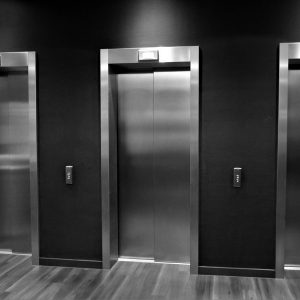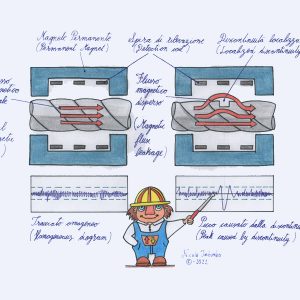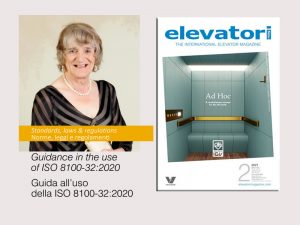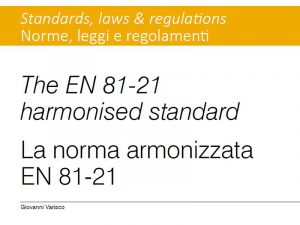EN 81-28 the harmonised standard
By Giovanni Varisco
Published on Elevatori Magazine Issue 2 Year 2018
The standard EN 81-28 (Remote alarm on passenger and goods passenger lifts) was published back in 2003, even though lifts complying with Directive 95/16/EC had to be equipped with the two-way communication device already from 1st July 1999 following the entry into force of that European standard.
Following the recent enforcement of the new Lifts Directive (2014/33/EU) and the publication of the new harmonised standards EN 81-20&50, EN 81-28 is being amended and the differences
introduced are summarised as follows:
• the obvious updating of the references to EN 81-1&2 harmonised standards, now replaced by those to EN 81-20&50 harmonised standards,
• information on the charge level of the batteries used for the operation of the device,
• the sound levels of the alarm system,
• the indication in the car of the failure of the communication system with the rescue centre.
Assumptions
The main assumptions underlying the EN 81-28 harmonised standard are:
• the transmission network used is not subject to failure;
• failure of the power supply network affecting all lifts in the same geographical area at the same time shall not be considered as a failure;
• as a general risk taken into consideration, the standard is aimed at the risk of persons being trapped in the lift car due to a lift car failure.
Requirements
The system shall ensure that alarms are transmitted once they have been issued with the necessary repetitions in the event of failure of the necessary communication. The end of the alarm shall be communicated (activated) by the system on which it was started.
No alarm shall be lost, not even due to power supply problems and, in the case of battery emergency power supply, the rescue centre shall be informed in the case charge levels become insufficient.
Both visual and audible signals in the car (the latter of an appropriate level in the event of excessive local noise) must inform passengers who are trapped in the lift that communication between the car and the rescue centre is being established correctly.
It must be possible to filter out alarms that can be considered as false, such as those occurring:
• with the car at landing and open doors (unlocked in the case of manual doors), or
• with the car moving towards a stop.
The alarm system shall be capable of operating within the effective operating time interval of the lift and shall periodically simulate a transmission with an interval set by the owner according to the passengers’ needs, but never exceeding three days.
Any failure of this transmission simulation must be indicated in the lift car to inform the owner accordingly.
No alarm shall be lost or blocked, especially in the event of a power failure.
If this latter is an emergency power supply, it is necessary to indicate any fault both to the rescue centre and inside the installation site and therefore the source
of the alarm, and this can be considered to occur whenever the emergency power supply is not able to handle one hour of the device operation to which now it should be added a quarter of an hour of voice operation for communications between the car and the rescue centre.
The rescue centre must be able to automatically identify the lift from which the alarm was received so as to relieve the trapped person from the need to notify the lift details (exact address).
Notifications
Visible and audible signals must be provided inside or above the car push button panel.
A yellow button is required and must light up after an alarm has been validated and must remain so until the alarm is over.
A sound signal between 35 dB(A) and 65 dB(A) shall be added, which can be adjusted to suit the noise conditions of the site. The sound level can only be adjusted by authorized personnel and in very noisy places, such as railway stations and similar, it can reach 80 dB(A).
This signal shall also be activated following validation of an alarm and shall be required to remain active until voice communication between the car and the rescue centre is established.
Information for the Owner The Instruction Manual of the bi-directional device must contain many useful information required for the proper operation of the remote alarm in relation to the need that:
• the Owner guarantees a connection with the rescue centre;
• the device is operational whenever two-way communication is required;
• voice communication from the rescue centre is checked periodically;
• information is provided on how the alarm is used by users;
• the minimum maintenance requirements necessary for proper operation are known;
• information is available on changing the operating parameters (telephone numbers, etc.).
General information for rescue activity
The maximum time between the reception of an alarm by the rescue centre and its recognition towards the car shall not exceed 5 minutes.
After such recognition, the rescue intervention time (meant as waiting time for the arrival at the lift) must be as short as possible, i.e. not more than one hour under normal conditions considered to occur in the absence of traffic interruptions or adverse weather conditions.
Persons in charge of alarm handling and those involved in the rescue operations must be suitably trained.
This means that there is an obvious need for continuous training to provide appropriate information about the equipment which over the time undergo technological improvements or replacements. This concerns transmission equipment as well as lift equipment It should be noted that the information contained in this point relevant to the instructions do not come from a mandatory Annex to the harmonised standard but from an informative Annex, which makes these concepts equivalent to the content of a note and therefore comparable to a suggestion that is not mandatory but certainly useful.
Consequently, the minimum intervention time stated in EN 81-28 standard could be less than the 60 minutes required by stricter national standards depending on the intended use of the lift and the building installed in it.
This reduction should therefore be taken into account both in the design of the rescue centre and in the planning of lift intervention activities.












